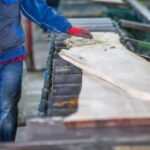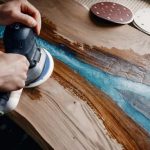Are you a woodworking enthusiast looking to improve your precision and accuracy when it comes to measuring angles? In this article, we will explore how to measure an angle in woodworking and the crucial role it plays in the success of your projects. Whether you are a beginner or a seasoned woodworker, understanding the importance of accurate angle measurement is essential for achieving professional results.
When it comes to measuring angles in woodworking, having the right tools is crucial. We will discuss the different tools needed for measuring angles, including the protractor, bevel gauge, and combination square. These tools are essential for ensuring that your angles are precise and consistent, ultimately leading to better quality craftsmanship in your woodworking projects.
In addition to discussing the necessary tools, we will also dive into various techniques for measuring angles accurately. From using a protractor to setting the bevel gauge and utilizing the combination square, we will provide you with practical tips and guidelines for ensuring that your angle measurements are spot on. By mastering these techniques, you can avoid common mistakes and achieve greater accuracy in your woodworking endeavors.
Tools Needed for Measuring Angles in Woodworking
When it comes to woodworking, precision is key, and measuring angles accurately is essential for the success of any woodworking project. To ensure that your angles are measured correctly, you will need the right tools for the job. In this section, we will discuss the three essential tools needed for measuring angles in woodworking: protractor, bevel gauge, and combination square.
Protractor
A protractor is a simple yet effective tool for measuring and marking angles in woodworking. It consists of a flat semicircular plastic or metal base with degree markings along the curved edge. To use a protractor, simply place it on the surface of the wood and align it with the angle you want to measure. Then, read the measurement marked by the pointer to determine the angle.
Bevel Gauge
A bevel gauge is another indispensable tool for measuring angles in woodworking. It consists of a handle attached to a metal blade that can be adjusted to any angle. To use a bevel gauge, set the desired angle by loosening the screw that holds the blade in place, then align it with the angle on your workpiece and tighten the screw to lock it in position.
Combination Square
The combination square is a versatile tool that can be used for various measurements in woodworking, including angles. It consists of a ruler with a head that can be adjusted and locked at different angles. To measure an angle using a combination square, simply adjust the head to match the angle you want to measure, then use it as a guide to mark or cut your workpiece accordingly.
Using these tools correctly is crucial for accurate angle measurement in woodworking projects. By understanding how to measure an angle in woodworking using these tools, you can ensure precise cuts and joints for your projects.
Techniques for Measuring Angles Accurately
Measuring angles accurately is essential in woodworking to ensure that cuts and joints fit together seamlessly. There are various techniques and tools that woodworkers can use to measure angles with precision. Three commonly used tools for measuring angles in woodworking include the protractor, bevel gauge, and combination square.
Using a protractor is one of the simplest ways to measure an angle in woodworking. Position the center point of the protractor at the vertex of the angle, then line up one side of the angle with the base line of the protractor. Read the measurement where the other side of the angle intersects with the protractor to determine the angle.
Another useful tool for measuring angles is a bevel gauge. To measure an angle using a bevel gauge, simply loosen the locking mechanism, set the gauge to match the angle you want to measure, and then tighten it in place. Once set, you can transfer this measurement directly onto your workpiece.
The combination square is also a versatile tool for measuring angles accurately in woodworking. By adjusting its ruler to different positions on its head, woodworkers can effectively determine and replicate various angles for their projects. This tool not only measures but also serves as a guide for cutting or marking lines at precise angles on wood surfaces.
These techniques demonstrate how important it is for woodworkers to have an understanding of how to measure an angle in woodworking accurately. Whether it’s using a protractor, setting a bevel gauge or utilizing a combination square, mastering these skills will contribute significantly to achieving precise cuts and joints in woodworking projects.
Common Mistakes to Avoid When Measuring Angles in Woodworking
When it comes to woodworking, accurate angle measurement is crucial for creating precise and seamless joints, cuts, and overall project alignment. However, there are common mistakes that woodworkers often make when measuring angles that can lead to inaccurate cuts and botched projects. Avoiding these mistakes will not only save time and materials but also result in a more professional finished product.
Not Using the Right Tools
Using the correct measuring tools is essential for accurate angle measurement in woodworking. While it may be tempting to eyeball an angle or use a makeshift measuring tool, such as a random piece of cardboard or paper, this will likely lead to imprecise cuts and joints. Investing in quality measuring tools such as a protractor, bevel gauge, or combination square is crucial for achieving precision in your woodworking projects.
Incorrect Positioning of the Measuring Tool
Another common mistake when measuring angles in woodworking is improper positioning of the measuring tool. Whether it’s failing to place the protractor or combination square flush against the workpiece or not ensuring that the bevel gauge is securely set at the desired angle, inaccurate measurements can easily occur if the tools are not positioned correctly. Taking the time to properly position your measuring tool before taking any measurements will greatly improve accuracy.
Overlooking Calibration and Adjustments
Calibration and adjustments are often overlooked when it comes to angle measurement in woodworking. Over time, measuring tools can become slightly misaligned or lose their accuracy. Failing to calibrate your measuring tools or ignoring potential adjustments can result in incorrect angle measurements. Regularly checking and calibrating your tools is key to ensuring that they provide accurate measurements for your woodworking projects.
By being aware of these common mistakes and actively avoiding them, woodworkers can significantly improve their accuracy when measuring angles for various woodworking projects. Attention to detail and precision during the measurement process will ultimately lead to better-fitting joints, cleaner cuts, and more professional results in all aspects of woodworking.
Tips for Choosing the Right Measuring Tool for the Job
When it comes to woodworking, choosing the right measuring tool for the job is crucial in ensuring accurate and precise angles. There are several factors to consider when selecting the appropriate tool for angle measurement in woodworking.
One of the most common tools used for measuring angles in woodworking is the protractor. This simple yet effective tool allows woodworkers to measure and mark angles with ease. It is especially useful for determining the angle of a cut or joint, making it an essential tool in any woodworker’s arsenal.
Another important tool for measuring angles in woodworking is the bevel gauge. This handy tool allows woodworkers to set and transfer angles with accuracy, making it ideal for tasks such as creating bevel cuts or marking out angled joinery. The bevel gauge is versatile and easy to use, making it a valuable addition to any woodworking toolkit.
Lastly, the combination square is another key tool for measuring angles in woodworking. With its ability to measure both 90-degree and 45-degree angles, as well as serve as a straight edge and depth gauge, the combination square offers great versatility for woodworkers. Its precise measurements make it an essential tool for accurate angle measurement.
| Measuring Tool | Key Features |
|---|---|
| Protractor | Simple, effective, ideal for determining cut or joint angles |
| Bevel Gauge | Versatile, accurate, perfect for bevel cuts and angled joinery |
| Combination Square | Versatile, precise measurements, essential for accurate angle measurement |
Practical Applications of Measuring Angles in Woodworking
Measuring angles accurately is essential in woodworking, especially when it comes to making precise cuts for mitre and bevel joints, as well as creating strong and seamless joinery. Whether you are working on a simple DIY project or a more complex woodworking endeavor, having the right tools and techniques for measuring angles can make a significant difference in the quality and accuracy of your work.
One of the most common practical applications of measuring angles in woodworking is for making mitre cuts. A mitre cut is made by angling the blade of a saw to create an edge that will fit perfectly with another angled piece, typically at a 45-degree angle. This type of cut is commonly used in creating frames, molding, and other decorative elements in woodworking projects.
Another important application of angle measurement in woodworking is for creating bevel cuts. Bevel cuts are made by tilting the saw blade to an angle other than 90 degrees, resulting in edges that are not perpendicular. This technique is often used for creating angled edges on tabletops, cabinet doors, and other furniture components to add visual interest and uniqueness to the design.
Lastly, precise angle measurement is crucial for joinery in woodworking. Whether you are creating dovetail joints, mortise and tenon joints, or finger joints, accurately measuring and cutting angles is essential for ensuring that the pieces fit together snugly and securely. Without proper angle measurement and execution, joinery can become weak or misaligned over time.
Understanding how to measure an angle in woodworking is fundamental to achieving accurate cuts and strong joints. With the right tools and techniques at your disposal, you can take your woodworking skills to the next level and create professional-quality projects with precision and finesse.
| Woodworking Technique | Importance of Accurate Angle Measurement |
|---|---|
| Mitre Cuts | Essential for creating perfect corners on frames and moldings |
| Bevel Cuts | Necessary for adding visual interest to furniture components |
| Joinery | Vital for ensuring strong and seamless connections between wood pieces |
Advanced Angle Measuring Techniques for More Complex Woodworking Projects
When it comes to more complex woodworking projects, the accuracy of angle measurement becomes even more crucial. Whether you’re tackling advanced joinery or intricate design elements, having the right techniques for measuring angles can make all the difference in the success of your project. Here are some advanced angle measuring techniques to help you tackle those more complex woodworking tasks:
- Digital Angle Gauge: A digital angle gauge is a handy tool that allows you to precisely measure and transfer angles. Simply place the gauge on the surface you want to measure, zero it out, then transfer the exact angle to your workpiece.
- Scribing Techniques: When dealing with irregular or uneven surfaces, scribing can be a useful technique for transferring and measuring angles. By using a scribe or marking knife, you can accurately mark an angle directly onto your workpiece for precise cuts and joinery.
- Angle Finder Apps: In this digital age, there are now mobile apps available that can help you measure and calculate angles with ease. These apps often use your device’s built-in gyroscope or accelerometer to provide accurate angle measurements for your woodworking projects.
These advanced techniques can be incredibly valuable when working on complex woodworking projects that require a high level of precision. By utilizing these tools and methods, you can ensure that your angles are measured accurately and translated effectively onto your workpieces.
Remember, practicing these advanced angle measuring techniques may take some time to master, but the investment in precision will pay off in the quality of your woodworking projects. Whether it’s creating complex joints or crafting intricate designs, having a solid understanding of how to measure angles in woodworking will elevate the overall craftsmanship of your creations.
Conclusion
In conclusion, mastering the art of measuring angles in woodworking is crucial for achieving precision and accuracy in your projects. Whether it’s crafting intricate joinery, creating seamless mitre cuts, or perfecting bevel cuts, the ability to measure angles with precision is essential for successful woodworking. By understanding the importance of angle measurement and utilizing the right tools and techniques, woodworkers can elevate the quality of their work and ensure that every piece fits together seamlessly.
One of the most important aspects to consider when measuring angles in woodworking is the choice of the right measuring tool. Whether it’s a protractor, bevel gauge, or combination square, each tool has its own advantages and ideal applications. Understanding how to use these tools effectively is key to achieving accurate measurements and ensuring that your woodworking projects turn out exactly as planned.
Additionally, being aware of common mistakes to avoid when measuring angles in woodworking can save time and materials. By paying attention to details such as proper positioning of the measuring tool, ensuring a stable work surface, and double-checking measurements, woodworkers can avoid costly errors and improve the overall quality of their craftsmanship.
In essence, precision in angle measurement is not only a skill but also an essential element for achieving excellence in woodworking. Therefore, learning how to measure an angle in woodworking accurately is fundamental for any craftsman aspiring towards perfection in their projects.
Frequently Asked Questions
How Do You Measure an Angle Correctly?
Measuring an angle correctly requires the use of a protractor. Place the center of the protractor at the vertex of the angle and align one side along the 0-degree line. Then, read the measurement where the other side intersects.
How Do You Find the Measure of an Angle?
To find the measure of an angle, you can use a protractor to determine the number of degrees between its two sides. Simply place the protractor on one side of the angle and read off the degree measurement where it intersects with the other side.
How Do You Saw Angles on Wood?
When sawing angles on wood, it’s essential to have a miter saw or miter box to ensure precision. Set your desired angle on the saw or box, hold your wood securely, and carefully cut along your marked line to achieve accurate angled cuts.

Hi everyone! I’m a woodworker and blogger, and this is my woodworking blog. In my blog, I share tips and tricks for woodworkers of all skill levels, as well as project ideas that you can try yourself.





